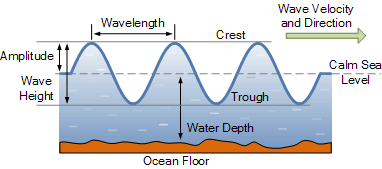
Wave Energy
Wave Energy Uses the Power of the Waves
![]() Ocean wave energy, or just simply Wave Energy, is another type of ocean based renewable energy source that uses the power of the waves to generate electricity. Unlike tidal energy which uses the ebb and flow of the tides, wave energy uses the vertical movement of the surface water that produce tidal waves.
Ocean wave energy, or just simply Wave Energy, is another type of ocean based renewable energy source that uses the power of the waves to generate electricity. Unlike tidal energy which uses the ebb and flow of the tides, wave energy uses the vertical movement of the surface water that produce tidal waves.
Wave power converts the periodic up-and-down movement of the oceans waves into electricity by placing equipment on the surface of the oceans that captures the energy produced by the wave movement and converts this mechanical energy into electrical power.
Wave energy is actually a concentrated form of solar power generated by the action of the wind blowing across the oceans surface. As the suns rays strike the Earth’s atmosphere, they warm it up. Differences in the temperature of the air masses around the globe causes the air to move from the hotter regions to the cooler regions, resulting in winds.

As the wind passes over the surface of the oceans, a portion of the winds kinetic energy is transferred to the water below, generating waves.
In fact, the ocean could be viewed as a vast storage collector of energy transferred by the sun to the oceans, with the waves carrying the transferred kinetic energy across the surface of the oceans. Then we can say that waves are actually a form of energy and it is this energy and not water that moves along the ocean’s surface.
These waves can travel (or “propagate”) long distances across the open oceans with very little loss in energy, but as they approach the shoreline and the depth of the water becomes shallower, their speed slows down but they increase in size. Finally, the wave crashes onto the shoreline, releasing an enormous amount of kinetic energy which can be used for electricity production.
A breaking waves energy potential varies from place to place depending upon its geographic location and time of year, but the two main factors which affect the size of the wave energy are the winds strength and the uninterrupted distance over the sea that the wind can blow.
Then we can say that “Wave Energy” is an indirect form of wind energy that causes movement of the water on the surface of the oceans and by capturing this energy the motion of the waves is converted to mechanical energy and used to drive an electricity generator. In many respects, the technology used for capturing this wave energy is similar to tidal energy or hydroelectric power.
The kinetic energy of the wave turns a turbine attached to a generator, which produces electricity. However, the open oceans can be a stormy and violent environment, resulting in the wave energy machines being destroyed by the very energy they were designed to capture.

In its simplest terms, an ocean wave is the up-and-down vertical movement of the sea water which varies sinusoidally with time. This sinusoidal wave has high points called crests and low points called troughs.
The difference in height of a wave between the crest and the trough is called the peak-to-peak amplitude, then the waves amplitude or height is the center of these two points and corresponds to the actual sea level when there is no movement of the water, in other words, a calm sea.
The amplitude of an ocean wave depends on the weather conditions at that time, as the amplitude of a smooth wave, or swell, will be small in calm weather but much larger in stormy weather with strong gales as the sea water moves up and down.
As well as the amplitude of the wave, another important characteristic is the distance between each successive crest, or trough, known as the wave period, ( T ). This wave period is the time in seconds between each crest of the wave. Then for a gentle swell this time period may be very long, but for a stormy sea this time period may be very short as each wave crashes onto the one in front.
The reciprocal of this time ( 1/T ) gives us the fundamental frequency of the ocean wave relative to some static point. Smaller periodic waves generated or superimposed onto this fundamental wave such as reflected waves are called harmonic waves. Then the frequency and amplitude characteristics of a wind-generated wave depend on the distance the wind blows over the open water (called the fetch), the length of time the wind blows, the speed of the wind and the water depth.
Waves transport energy from where they were created by storms far out in the ocean to a shoreline. But a typical ocean wave does not resemble a perfect sinusoid, they are more irregular and complex than a simple sinusoidal wave. Only the steady up-and-down movement of a heavy swell resembles a sinusoidal wave much more than the chaotic nature of locally generated wind waves, as real sea waves contain a mixture of waves with different frequencies, wave heights and directions.
Wave Power Devices
Ocean wave energy has many advantages over ocean wind energy in that it is more predictable, less variable and offers higher available energy densities. Depending on the distance between the energy conversion device and the shoreline, wave energy systems can be classified as being either Shoreline devices, Nearshore devices or Offshore devices. So what is the difference between these three types of energy extraction devices.

